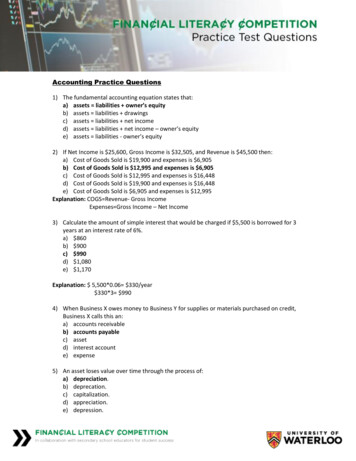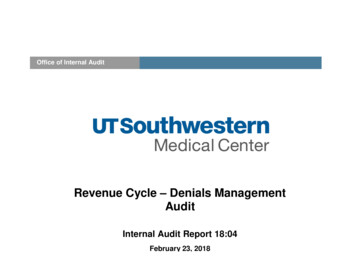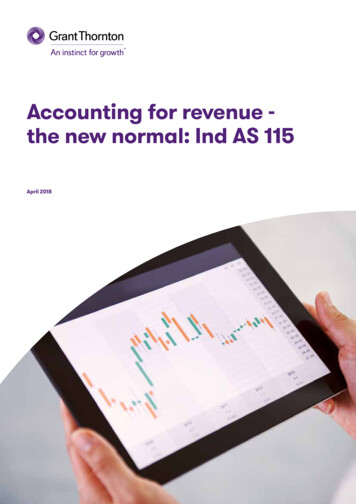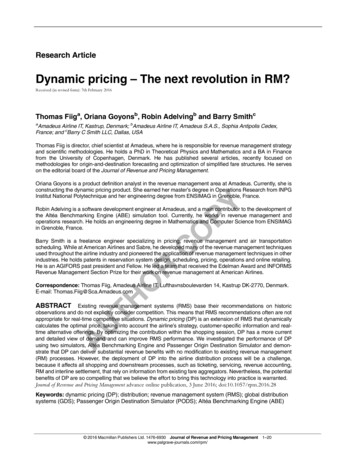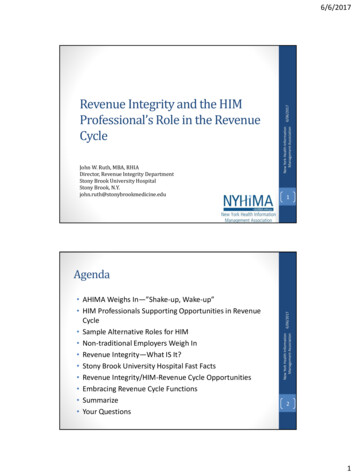
Transcription
Effective Revenue Managementin the Hospitality IndustryWhite Paper
DATA MANAGEMENT FOR UTILITIESEffective Revenue Managementin the Hospitality IndustryWhite PaperDisclaimerThe information and opinions in this document were prepared by EyeforTravel Ltd and itspartners. EyeforTravel Ltd has no obligation to tell you when opinions or information inthis document change. EyeforTravel Ltd makes every effort to use reliable, comprehensiveinformation, but we make no representation that it is accurate or complete. In no event shallEyeforTravel Ltd and its partners be liable for any damages, losses, expenses, loss of data, lossof opportunity or profit caused by the use of the material or contents of this document.No part of this document may be distributed, resold, copied or adapted withoutprior written permission from EyeforTravel Ltd.AuthorMorag Cuddeford-JonesEditorCarlos Márquez Salazarcarlos@fc-bi.com EyeforTravel Ltd. 2013EyeforTravel Ltd is a registered company in England and Wales - Registered Number06286442. 7-9 Fashion Street, London, E1 6PX, UKwww. eyefortravel.comEffective Revenue Management in the Hospitality Industry 2
ACKNOWLEDGMENTSAcknowledgmentsEyeforTravel would like to thank the following individuals and organizations for providing inputs for this White Paper.Josep Bernat, Chief Revenue Officer, OdigeoTom Botts, EVP and Chief Customer Officer, DenihanJeremie Catez, Regional eCommerce Manager, Novotel North AmericaAsh Kapur, Vice President Revenue Management, Starwood Capital Groupwww. eyefortravel.comEffective Revenue Management in the Hospitality Industry 3
OVERVIEWOverviewTechnological innovation and the increasingimportance of digital are creating a shiftingconsumer landscape for the travel industry. Notonly is there disruption in how customers choose toresearch and interact with travel brands but traditionalpurchasing behaviors are evolving. Revenue managersare having to look afresh at their modeling to improveoutcomes. For example, assumptions about last-minutepricing are being challenged as a surge in use ofthe mobile channel reveals a shift away from pricesensitivity and towards convenience and availability.This white paper draws on information exclusiveto Eyefortravel regarding executive’s opinions oncustomer channel choice as well as data from travelcustomers themselves revealing channel choice andbooking behavior. This is supported by interviews withkey executives within the RM space, highlighting thechallenges they face and how they propose to addressthese. This white paper will reveal where the future ofRM lies and what travel executives need to considernow to maximize its returns.Reliant on volumes of customer data to make accuraterevenue predictions, revenue management systems(RM) should be enjoying the start of a halcyon period.Yet fewer than 20% of North American hotels use them.The reasons behind slow RM implementation are asvaried as the hotel industry itself. In many ways, thehighly fragmented nature of the North Americanhotel sector is to blame. Sole operators with waferthin margins simply do not have the capital orexperienced executives to implement such a system.Other hotels benefit from umbrella group brands andyet are still considered lone operatives, responsible fortheir individual revenues. For those who do benefitfrom centralized operations within the group brand,organizational silos prevent the seamless flow ofinformation and expertise across departments that isneeded to optimize RM outputs.Hotels whose structure and financing allow for RMimplementation face further hurdles. The emergenceof much more detailed customer data from digitalchannels in particular is undoubtedly a boost to theirRM strategies. However, the vast array of channelsdelivering this information results in data that isduplicated, inaccurate and confusing. Far fromdelivering a clearer picture of future customer journeys,‘big data’ is obscuring it.www. eyefortravel.comEffective Revenue Management in the Hospitality Industry 4
CHALLENGES FOR REVENUEMANAGEMENTThe Challenges for Revenue ManagementRevenue management systems (RM) when deployedcorrectly have been proven to directly generate a 5-10%uplift in sales. Its limited adoption so far indicates thereare a number of challenges yet to be overcome beforeit can fully demonstrate its worth to a wider audience.Of these, there are five key elements that must beconsidered: Return on investment Clean data Strategic insight into the use of that data Organizational consensus Constantly changing customer landscapeReturn on investmentOf the five elements, the first and simplest to address isthat of return on investment (ROI). RM systems presenta fixed cost to the hotel. While this varies depending onsupplier and level of technical sophistication, it can bemeasured against the potential returns it might deliver –the 5-10% mentioned above.That said, smaller hotels with lower potential revenuesare not excluded from benefiting from RM. Accessto RM is one of the attractions of becoming part of alarger group and should be a point of consideration forany hotel director when considering joining such analliance.As will be discussed later in this briefing, access to sucha system is not the only consideration as RM works bestwhen its variables are tailored precisely to the propertyinvolved. A ‘vanilla’ RM solution covering a variety ofdiverse properties serving differing customer groupsmay be worse than none at all.www. eyefortravel.comClean dataIt is a common complaint from travel brand marketersthat they don’t need more data, they need insight. Themultichannel environment has undoubtedly increasedthe volume of data available to travel brands and looksset only to increase as channel owners, particularlythose in the social sphere, look to emphasize thebenefits their increasingly deep profiling can provide.But for useful insights to be drawn, work still needs tobe done on the raw data. Specifically the high volumeof inaccurate data swirling around customer files. Thereis an abundance of clean data available – data emergingfrom transactions and travel partners such as airlineswhere accuracy is a result of tight controls (passport andfinancial data being two of the most likely to be correct).However data supplied by the customer or gathered inby person to person contact must be examined morecarefully.Ash Kapur, Vice President, Revenue Management,Starwood Capital Group insists: “Clean data isthe challenge from the get-go. Strong revenuemanagement can provide codes and market segmentsthat are clean but there is still a struggle. Front of housestaff under pressure are often required to fill in datafrom guests’ passports but, when faced with a line, aretempted to check the first entry on the list. We seemedto have an awful lot of guests from Afghanistan.”Data arising from location-based services or historicalpurchase activity can be indicative of customer behaviorbut is not guaranteed accurate. Purchases can be madeon behalf of others, location-based data from mobilephones can be wrong simply by dint of another partyborrowing the device. But these are elements overwhich the travel brand has no direct control.Effective Revenue Management in the Hospitality Industry 5
CHALLENGES FOR REVENUEMANAGEMENTPerson to person contact can however be more tightlymanaged. The check-in process remains central to therevenue manager’s ability to garner data. In a digitalage, there is a temptation to ascribe more importanceto automated information than personal interaction andyet the latter is where the detailed information so criticalto determining customer preference can be found.Revenue managers will have to work with both theirhuman and technological resources to ensure cleandata can support their RM strategies.Strategic insightEradicating contaminated data is critical to providinga strong foundation on which to run RM programshowever the correct oversight is also vital if systems areto deliver the desired outcome.Tom Botts, Denihan’s EVP and Chief Customer Officernotes that some providers are moving in this direction.“We partnered with Duetto and are in the processof rolling out its strategic RM system. We chose it fora couple of reasons: We wanted a more analytical,systemized approach that was more sophisticated thanspreadsheets and we needed additional control. Thesystem lets us observe how decisions are made acrossthe company and means we are able to bring in newthinking and new ways of doing things.”“The main issue is that most people are using a RMsystem that was designed 50 years ago. You didn’t haveas much data or the facilities that we have today,” Bernatstates.Revenue managers have to understand the importanceof flexibility and supplementary information that willinform how they interpret the financial data deliveredby RM systems. Increasing availability of real time datameans managers must decide what are the criticalpieces of information to focus on and ensure anysystems or processes they use are able to deliver themin a timely manner.incorporated and much more situational such as theimpact local events and external macro influences suchas economic conditions will have on their business.For companies questioning the value of investment inRM systems, the realization that such investment mustbe supported by a dedicated strategy and suitablyskilled staff resource can prove off-putting. This isparticularly the case when previous attempts have notincorporated a joined up approach between strategicRM leadership and technologies, leading to the beliefthat RM systems do not deliver the value against costsome resellers claim.Historically, RM has been a long sell, as it's beenchallenging to prove value is created by the tool andnot just a competitor having a bad day.It's clear that an approach that brings together the latestin technology with usability in an RM system, would goa long way to alleviating such doubts.Organizational consensusThe lack of joined up approach has been central tothe lack of uptake of RM systems to date. The NorthAmerican hotel sector is highly fragmented. Fromgeographic location to segmentation to internalstructure, there are a number of hurdles that RM mustovercome to be deployed seamlessly – and effectively.Even within groups that enjoy centralized marketing,sales and revenue functions the need for interdepartmental cooperation for effective managementis still a struggle. At the C-suite level, RM is viewed as acost that has yet to prove significant returns, a Catch-22situation where it must be run well and widely to proveits worth yet in many cases, hotels’ internal culturesneed to change for this to happen.“You need to know the limit of the machine,” Odigeo’sBernat states. “The question on the table is ‘what is thelong term strategy?’ You need to understand that thereare some things the computer cannot know.”Skilled people also have to have the capability tocombine these inputs with information not so easilywww. eyefortravel.comEffective Revenue Management in the Hospitality Industry 6
CHALLENGES FOR REVENUEMANAGEMENTChanging consumer landscapea wealth of information about location, preference,customer segment and advocacy (see figure 1).Perhaps the biggest challenge for RM systems isthe constantly changing consumer landscape. Themultichannel environment is presenting two distinctproblems: Data Purchasing behaviorData is a challenge, as mentioned above, simply becauseof the volumes the multichannel environment produces.As mobile accounts for 20% of travel transactions(eyefortravel, 2013), the volume of data needing to beanalyzed and processed has also grown. While an increasein social media interactions is yet to generate a significantrise in bookings through this channel, it already providesAs a result, RM systems need to not only process moredata but data of different types from a wide variety ofsources, often in real time. The burden on less flexiblesystems is great and their ability to process suchan abundance of information is limited. This is thentransferred to revenue managers who are faced with agrowing number of daily reports that they are unable toanalyze meaningfully or rapidly.Purchasing behavior is also evolving, creating entirelynew customer segments and windows of opportunity.Both managers and RM systems are having to frequentlyreassess their pricing strategies in line with thesenew customer paradigms. Mobile again is driving alarge portion of these new behaviors, particularly inFigure 1. Using social media as a marketing tool, June 20134035 IntermediaryMarketing Supplier Marketing37.835.931.73025.9252018.615.215Extremely ImportantVery ImportantNot ImportantImportant5.25010109.5Neither importantnor unimportant10Source: EyeforTravel Supplier and Intermediary barometers, 2013; “howimportant has the social media channel been for your organization in thelast three months? Please rate on the scale below against each of thefollowing:” 455 respondents(eyefortravel, 2013)www. eyefortravel.comEffective Revenue Management in the Hospitality Industry 7
CHALLENGES FOR REVENUEMANAGEMENTTable 1. Devices and websites customers are most likely to use to make a last-minute booking1 weekbefore2-3 daysbefore1 daybeforeOn the dayNeverResponsesTravel provider on a desktop computer57.6%13.1%3.9%2.5%22.9%15,176Travel agency on a desktop computer53.0%15.7%4.4%2.1%24.7%15,173Travel provider on a tablet computer45.6%13.8%5.3%2.6%32.7%15,168Travel agency on a tablet computer45.0%13.4%4.5%3.1%34.0%15,169Travel provider on a mobile43.9%12.7%5.7%3.5%34.2%15,168Travel agency on a mobile43.6%12.8%5.3%3.5%34.8%15,167I would call the travel provider personally47.8%13.2%6.7%4.9%27.3%15,169Source: EyeforTravel consumer research in association with WAYN, May 2013; "On which device and website are you most likely to make a last-minute booking?"(eyefortravel, 2013)the last minute segment where it is much more thetransactional channel of choice than in longer termtravel purchases (see table 1).Pricing strategy itself is being impacted by multichannelas online travel agencies (OTA), metasearch andprice consistency begin to affect how hotels targetcustomers. Discounting is no longer the preserve ofthe last-minute segment, indeed often this customer ishappy to pay a premium for convenience and choice.Revenue management systems in the future will notonly have to accommodate large volumes of dataand process them in an easy-to-manage format forrevenue managers but will have to be flexible enoughto take into account changes in consumer behavior aspurchasing trends remain in a constant state of flux.www. eyefortravel.comEffective Revenue Management in the Hospitality Industry 8
EL CORTEZ HOTEL & CASINORevenue Management in Action –Case Study: El Cortez Hotel and CasinoAn example of revenue management adapting tothe shifting consumer paradigm is El Cortez Hotel &Casino in Las Vegas. After the economic downturn in2008, casino revenues were struggling. Far from beinga temporary blip, the downturn had permanentlychanged the way casino customers were spending andthe business needed to adapt.Novotel’s regional ecommerce manager, Jeremie Catez,notes that the move from rates to price elasticity isa key component of the new revenue managementparadigm: “Everyone is talking about rate but we coulddo better with price elasticity. What is the customer’sbehavior if we lower the room by 10 bucks? How we canmeasure this is also a critical issue.”The systemEl Cortez also used the RMS to identify customersegments within the casino, noting that the lowestworth player segments were receiving complimentaryor discounted cash rooms that were unprofitable.The result was a standardized casino yielding processthat included variable casino cash and comp pricing.The hotel’s occupancy by casino players was lowered,freeing these rooms up to be marketed to moreprofitable paying guests.Working with revenue management consultants, ElCortez’s strategy was to generate incremental cashbusiness through transient and wholesale channels.The hotel installed Duetto’s cloud-based revenuemanagement system (RMS) that delivered marketintelligence, forecasting, pricing recommendationsand historical data comparison. Using an alerts feature,key dates were flagged up, a process often missed intraditional RM systems.To understand shopping behavior on a daily basis, theRMS tracked a JavaScript tag on the hotel’s bookingengine that monitored lost business. As a result, thehotel could then assess how a day’s pricing strategyimpacted the website’s booking conversion rate.New pricing approachWith more dynamic pricing the hotel was yielded muchmore frequently however pricing wasn’t just increasedacross the board. Data from the RMS revealed thatlower room rates were required midweek to be morecompetitive while prices could be raised during certainhigh pressure periods. Its discounting strategy was alsoreassessed, critically removing them during periodswhere the hotel could achieve capacity without them.Discounts still ran through third parties, generatingexposure and the cash average day rate (ADR) rose 10%with an average occupancy rise of 6.3%.www. eyefortravel.comThe hotel’s ability to remain competitive had beenaffected by its attitude to price consistency andoverselling. Until deploying the RMS it had failed tomaintain consistency with OTAs driving custom awayfrom direct sales and incurring 25% commissionmargins. In addition, its cheapest room rates onlyaccounted for 10% of inventory and once sold, ratesincreased by at least 10 making El Cortez less attractivein the price sensitive downtown Las Vegas market.To solve both these issues, the RMS ensures priceconsistency with OTAs increasing direct room nightsales by 10,000 or 130% and instituted a policy oflimited overselling of cheaper rooms during non-criticaloccupancy periods. Having solved its price consistencyissues, El Cortez actually extended its OTA network toextend its reach to new customer bases.The strategy has delivered a cash revenue increase yearon year of more than 30% in the first seven months of2013.Effective Revenue Management in the Hospitality Industry 9
EL CORTEZ HOTEL & CASINOTable 2. Key Performance Figures at El Cortez after RM Strategy OverhaulYoY Change (Jan - July 2013 vs. 2012)Number increase% increaseCash room nights (1)7,12218%Direct room nights (2)9,975130%Cash ADR10%Occupancy6.3%Cash revenue30.1%Source: DuettoHaving proven the utility of the RMS by modifyingexisting pricing strategies, El Cortez’s next phase is toextend the program’s reach. The three main areas ithopes to exploit are: Customer lifetime value Increase ADR Enhance digital presenceCustomer lifetime value – by calculating the totalpatron worth by customer through all revenue centersincluding gaming and non-gaming, their profitcontribution can be integrated into future revenuemanagement decisions.Increase ADR – using a dynamic room pricing by day forupgraded room types and promoting upgrades duringthe guest experience. Internal resources and hotelpartners can be deployed at four stages: Pre-bookingthrough offers; at the time of booking; post-bookingand at check-in.Enhanced digital presence – Expanding the hotel’ssocial media presence and using it for targetedmarketing as well as managing online content andmanaging reviews through OTAs and TripAdvisor.www. eyefortravel.comEffective Revenue Management in the Hospitality Industry 10
FUTURE OF REVENUE MANAGEMENTThe future of revenue managementTo ensure the success of revenue managementstrategies, hotel owners must be both convinced ofits ability to deliver return on investment as well asmade aware of the resources required to maximize itspotential.Starwood’s Kapur notes: “There’s a lot more comfortnow in knowing that we don’t need to drop rates lastminute because we know there’s a segment that bookson mobile.”Significantly, hotels need to ensure that theirorganizational structure supports a revenuemanagement policy. While wholesale reorganization isnot required, there must be a cultural understandingthat core departments such as marketing, sales andrevenue work together to share information critical toRM success.The ability to bring together and meaningfully analyzequantitative and qualitative data is a necessity as theinfluence of social media and user-generated contentsuch as reviews are recognized to impact customers’decision-making processes more than price differentialin many cases. Interviewees for this report noted thatfew RM systems are able to bring these two streams ofinformation together effectively but those that do arecreating demonstrable gains (see El Cortez case study).“The way companies were organized is dead. Today, if Ichange the price, it affects marketing and production’sbottom line financials. I need to know what the impactwill be and I need that answer immediately. Newsystems give you that vision,” Bernat reveals.“If one day we can mix data streams and have CRM andloyalty and customer information in the same system, itwill be fantastic,” Catez predicts.Denihan’s Botts notes that movements are beingmade in this direction: “We’re working on combiningmarketing, sales and revenue management all underone leader who has an overall understanding of thesethings. A common decision-making platform is critical.That doesn’t exist today in many cases and it’s going tohave to change.”A clean data palateAs multichannel puts a much greater focus on data,hotels need to be able to manage their informationwell. This means investing significantly in data cleansing,without which RM predictions will be at best inaccurate.The single customer view is a pressing issue in allsectors, not just travel, and brings with it questions ofdata protection, management and storage. Hotels willbe looking to RM systems providers for assistance inidentifying and managing the most beneficial streamsof information.www. eyefortravel.comMinimal information, maximumeffectivenessThe outputs generated by RM systems are no lessvoluminous and revenue managers interviewed for thisbriefing noted that reporting was becoming a criticalissue.Novotel’s Catez notes: “You can’t expect one human tolook at 25 reports. The reports are no longer fresh bythe time the managers get around to them. The worldis quicker and a lot of these things, even Twitter forexample, influence the pricing.”To deliver truly effective RM support, systems providersmust work to minimize the outputs managers have toanalyze on a daily basis. The risk of ‘information paralysis’is otherwise too great. The rise of the last-minutesegment along with booking services active 24/7 meansdynamic pricing is no longer a 9-5 job and profitabilitywill be increasingly dependent on the manager’s abilityEffective Revenue Management in the Hospitality Industry 11
FUTURE OF REVENUE MANAGEMENTto make swift decisions from timely and easily-digestedinformation.Successful RM providers will be those whose systemsare robust enough to not only aggregate data fromvarious customer touch points, across multiple channelsand different points in the customer journey – but tomake it usable and accessible to managers at all times.The growing ability to host RM systems in Software as aService (SaaS) or ‘Cloud’ technology will greatly increasemanagers’ ability to use dynamic pricing and react toreal-time changes in the marketplace.From a marketing perspective, the ability to use datato market through social channels, while not currentlya strong distribution channel, will become critical toenhancing reputation and market position.Revenue management systems must evolve to keeppace with hotel needs however hotels themselves mustalso evolve to maximize the potential revenue growththat these tools can provide.An industry evolutionTechnological advances have proven both a boon and abugbear to revenue managers. As customers make useof all the channels and devices available to them, thetsunami of data provides tantalizing opportunity butalso demands a great deal of resources to derive benefitfrom it. But hotel managers should look at using thesame technologies to support their RM tools.“We’re asking our partners to get on the sametechnological page. Some are better than others. We stillhave wholesalers faxing reservations and systems notprocessing them in real time. We need to have an overallunderstanding about what the connectivity strategyis for partners,” Botts insists. Indeed, the ability to keepup with real-time RM systems may prove a clincher forworking partnerships in the future: “If they’re not willingto participate in a realistic format, is that something theindustry should be participating in? I hope others arepressuring their partners to keep up,” he adds.From a data cleanliness perspective, introducingmobile check-ins removes pressure from front deskstaff to gather the detailed, accurate customer datarequired for one-to-one pricing strategies that willultimately become possible. However Kapur cautions:“In some cases technology has helped for pre-checkin and getting guests to enter in their data but I stillthink getting clean data in general is the fundamentalproblem.”www. eyefortravel.comEffective Revenue Management in the Hospitality Industry 12
REFERENCESReferenceseyefortravel (2013) Social Media and Mobile in Travel Distribution Report: Online strategies, consumer and industrytrends 2013. London: Eyefortravel.www. eyefortravel.comEffective Revenue Management in the Hospitality Industry 13
www. eyefortravel.com Effective Revenue Management in the Hospitality Industry 5 Revenue management systems (RM) when deployed correctly have been proven to directly generate a 5-10% uplift in sales. Its limited adoption so far indicates there are a number of challenges yet to be overcome before it can fully demonstrate its worth to a wider .






